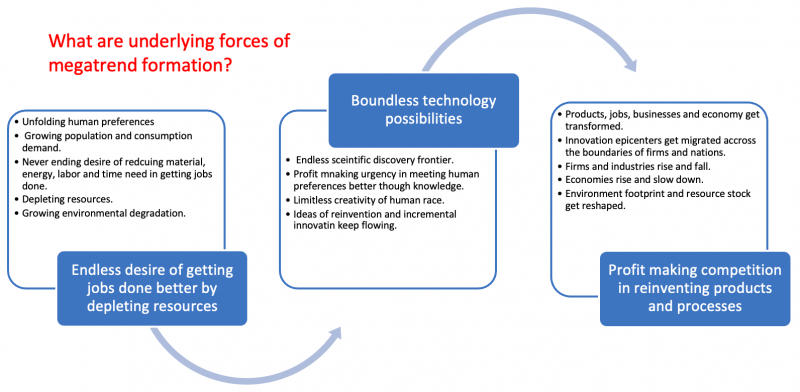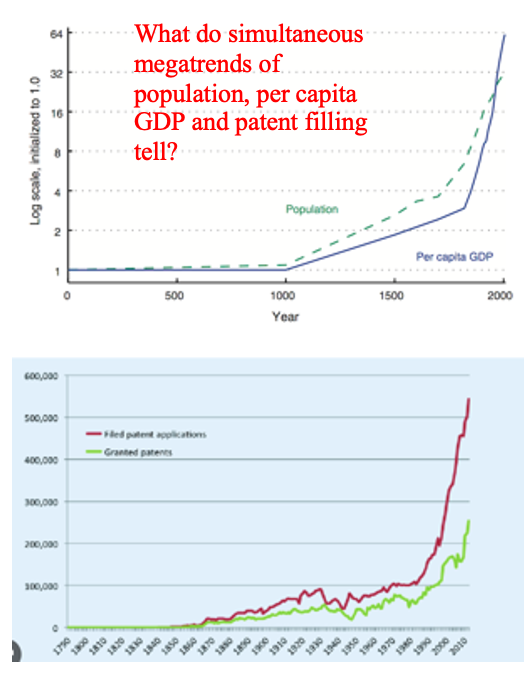Unfolding megatrends mark the progression of the human race. For recreating the world around us, they transform products, processes, industries, businesses, work, the economy, and society. For example, due to mechanization, the First Industrial Revolution formed a megatrend in production methods, creating an industrial economy while destroying cottage industries. It also destroyed the jobs of artisans and made millions of farmers eligible for factory work. Due to the continued quality improvement and cost reduction, the economy of the UK and the rest of Europe kept growing, reaching the top.
However, due to the changes in wind, water, and muscle energy by steam engines, a megatrend of pollution, emission, and natural resource depletion started to form. Since then, we have been observing multiple megatrends. The first industrial revolution also gave birth to a megatrend of the idea economy, dividing the world into two halves—idea producers and suppliers of material, energy, and labor for implementing them. Besides, the formation tendency of megatrends will keep growing, transforming products, work, business, the economy, and society. The underlying reason for the megatrend has been our endless desire to execute jobs better, unfolding technology possibilities, and profit-making competition.
Megatrends refer to the unfolding of Reinvention waves as Creative waves of destruction, transforming the global economy by driving Innovation, redefining business models, reshaping work, and migrating innovation epicenters. It has been happening due to profit-making opportunities in addressing our endless urgency of performing jobs better through reinventing products and processes by leveraging boundless technology possibilities.

Megatrends of Population, Ideas, and Economic Growth

The natural resource stock of the world is fixed. Due to growing consumption, this stock has been depleting. Hence, the reality could have been that along with population growth, the quality of living standard or GDP keeps declining. Based on such a belief, some economists, notably Thomas Robert Malthus, developed a theory relating to population growth and living standards. According to the Malthusian growth model, the growth of the food supply or other resources is linear. Consequentially, it will eventually reduce living standards to the point of triggering a population decline. Such a theory goes further, stating Malthusian crisis as the outcome of when population growth outpaces agricultural production. Thus, it will cause famine or war, resulting in poverty and depopulation.
However, to our surprise, the population and per capita GDP have been growing together. Notably, there has been exponential growth since the dawn of the first industrial revolution. The underlying factor has been the growth of ideas. The growth Flow of Ideas has been reinventing products and processes and incrementally advancing them. Invariably, these ideas have been extracting increasing economic value or Utility from per unit of material, energy, labor, and time. However, such a reinvention and Incremental innovation race has been transforming jobs, business, and migration of wealth creation epicenters. For example, ideas for scaling up steam engines and mechanization transformed the global economy, making the UK-led Europe most prosperous.
Highly related articles:
Megatrends of Creative Destruction
Megatrends Shaping Future of Work
Megatrends in Industrial Revolutions
Technology cores in unleashing creative destruction waves–—unleashing transformational changes
The transformational effect is at the core of megatrends. It unfolds due to the creative destruction effect of the rise of reinvention waves. At the maturity of products and firms, reinvention waves through the change of matured technology cores with emerging ones lead to the formation of megatrends, unleashing disruption due to the creative waves of destruction. Hence, at the core of megatrends of creative waves of destruction, there have been technology cores.
Technology cores fueling the creative waves of destruction
Past Megatrends underpinning industrial revolutions were fueled by the following major technology cores:
- Steam Engines and Automation in Textile,
- Automobile, Airplane, and Railway,
- Electricity and light bulbs,
- Telecommunication and Wireless communication,
- Sound and video recording, broadcasting and reproduction,
- Refrigeration and microwave heating,
- Transistor, lithography, and microprocessors,
- Graphical and multitouch user interfaces,
- Internal combustion engines, Electric motors, and
- Industrial automation.
Technology cores driving unfolding megatrends
Some of the technology cores driving the future and near future megatrends are as follows:
- Artificial intelligence (AI) and machine learning,
- The Internet of Things (IoT),
- Wearables and augmented humans,
- Blockchains and distributed ledgers,
- Digitally extended realities and Digital twins,
- Natural language processing, Voice interfaces, and chatbots,
- Computer vision and facial recognition,
- Unmanned aerial vehicles,
- Cloud, Edge, and Quantum computing, and
- Robotics, 3D printing, Process Automation, and Personal care.
Megatrends in Industrial Revolutions
The dissection of industrial revolutions reveals 10 megatrends, as shown below:
- Art->Tinkering->Science->Scalable inventions->Waves of Innovation
- Mechanical->Electrical->Electronics->Software
- Energy->Information->Cognitive
- Artisans-> capital-intensive mass production->software-centric monopolization
- Natural resource->labor->capital for mass production->ideas for creative waves with less labor
- UK->Europe->America->Japan->Asia
- Making->reengineering->reinnovation
- Skilled workforce->low skilled labor in mass production->decreasing labor need ->increasing inequality
- Renewable energy->non-renewable->Renewable
Megatrends shaping the future of work
What are the underlying megatrends shaping the future of work that underpin job loss prediction? The urgency of Getting jobs done better will keep driving innovation and reinvention, transforming the future of work. Due to technology progression urgency, R&D jobs will likely be exponentially growing. On the other hand, due to the varying complexity of automation software, centric automation will take over middle-layer managerial jobs while leaving dull jobs for humans. Changing demography will be forming megatrends in shaping the future of work. For example, there will be growing elderly care jobs. Sustainable development and localized production agenda will also contribute to the megatrends shaping the future of employment.
As explained, due to profit-making competition in creating economic value through leveraging technology possibilities, there will be megatrends of transformation. They will be transforming the way we live and work. Unfolding megatrends will be shaping jobs, businesses, the economy, and society through creative destruction effects. Although they appear random, fortunately, there are underlying patterns.




